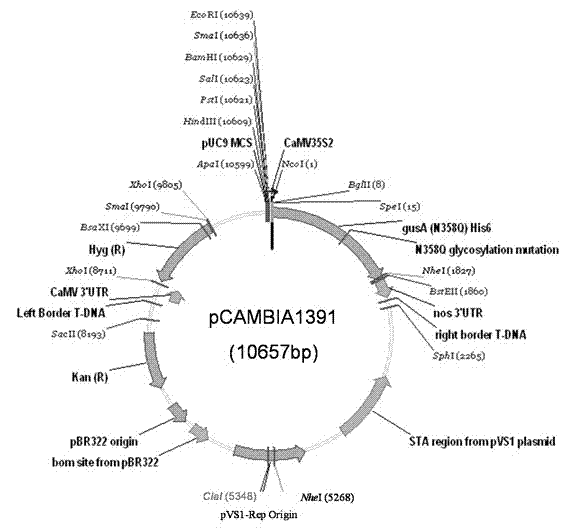Method for high-flux screening chemical excitons for inducing insect resistance of plants
A screening method and chemical excitation technology, which can be used in material excitation analysis, biological testing, material inspection products, etc., can solve the problems of cumbersome methods, low efficiency, and large biological assay workload, and achieve simple screening methods and reduced workload. Effect
- Summary
- Abstract
- Description
- Claims
- Application Information
AI Technical Summary
Problems solved by technology
Method used
Image
Examples
Embodiment 1
[0013] Example 1: The rice volatile linalool can attract the important natural enemy of the brown planthopper, the rice linalool synthase gene OSLIS As an example, the operation steps of the present invention are introduced.
[0014] 1. Linalool synthase gene OSLIS Cloning of promoter sequence and construction of pCAMBIA-LISp vector
[0015] Primers were designed according to the 1500 bp upstream of the transcription start site of the OsLIS gene sequence (GenBank database accession number is AK110925):
[0016] The forward primer is OsLISP-F:CG AAGCTT CGTGTTCATGTACCCCTTTT, reverse primer is OsLISP-R:AG GTC GAC GTGGCAAACCATAGATAAGC, for the convenience of cloning in the next step, HindⅢ and SalⅠ restriction sites were respectively designed at the underline. PCR amplification was carried out using rice genomic DNA as a template, and the amplified product was named LISp. The LISp and pCAMBIA1391 plasmids were double-digested with HindⅢ and SalⅠ, respectively, the digeste...
Embodiment 2
[0022] Embodiment 2: Jasmonic acid is used as the verification experiment of chemical elicitor
[0023] Jasmonic acid (jasmonic acid, JA) is a known bioactive small molecule that can activate rice-induced insect resistance, not only can induce rice to produce direct resistance to stem borer (Zhou G, et al. (2009) Silencing OsHI-LOX makes rice more susceptible to chewing herbs, but enhances resistance to a phloem feeder. Plant J 6 0: 638–648.), and can induce indirect resistance in rice (Lou Y, Du MH, Turlings TCJ, Cheng J, Shan WF (2005a) Exogenous application of jasmonic acid induces volatile emissions in rice and enhances parasitism of Nilaparvata lugens eggs by the parasitoid Anagrus nilaparvatae. Journal of Chemical Ecology, 31: 1985-2002). In this example, JA was dissolved in 50 mM phosphate buffer solution to a final concentration of 5 mg / L when spraying the shoots of JA, and 0.01% Tween-20 was added, and the transgenic rice lines L15-15 and L15-38 Spray 2 ml of ...
Embodiment 3
[0024] Example 3: Screening chemical elicitors from unknown active small molecule compounds
[0025] Dissolve 11 different small molecule compounds A, B, C, D, E, F, G, H, I, J, K with unknown biological activity in 50 mM phosphate buffer to a final concentration of 5 mg / L, and add 0.01 % Tween-20, spray the aerial part of rice line L15-38 in the same way as in Example 1, and use the phosphate buffer solution of spraying 0.01% Tween-20 as a contrast. After 48 h of treatment, the activity of GUS protein in the leaves was measured. At the same time, the wild-type rice was treated in the same way, and after 48 hours of treatment, the behavioral response of the wasp to small molecule-treated wild-type rice plants and buffer-treated wild-type rice plants was measured. The "Y" type olfactometer was used to measure the behavioral response of 50 jasmonic wasps to rice volatiles. The specific operation steps refer to: Lou Y, Du MH, Turlings TCJ, Cheng J, Shan WF (2005a) Exogenous appl...
PUM
 Login to View More
Login to View More Abstract
Description
Claims
Application Information
 Login to View More
Login to View More - R&D
- Intellectual Property
- Life Sciences
- Materials
- Tech Scout
- Unparalleled Data Quality
- Higher Quality Content
- 60% Fewer Hallucinations
Browse by: Latest US Patents, China's latest patents, Technical Efficacy Thesaurus, Application Domain, Technology Topic, Popular Technical Reports.
© 2025 PatSnap. All rights reserved.Legal|Privacy policy|Modern Slavery Act Transparency Statement|Sitemap|About US| Contact US: help@patsnap.com

